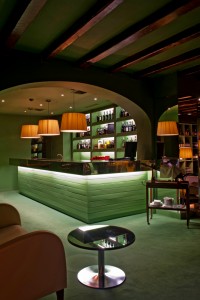While Portugal has some excellent table wines, its glory is in the dessert wines, from grapes grown along the Douro River in the north of the country. The grapes have names that are strange to American ears: Touriga Franca, Tinta Roriz, Tinta Barroca, Touriga Nacional, Tinto Cão and Tinta Amarela. The name of the wine they are made into comes from the city at the mouth of the Douro, called Porto. Hence the wine famous around the world for its richness, depth and high alcoholic content is called Port.
But if you are in Lisbon you are three hours south of Porto. So if you want to taste Port, where do you go? The answer to that question is very simple: the Instituto Dos Vinhos Do Douro e Do Porto (the Institute for the Wines of the Douro and of Porto). It’s located at 45 Rua São Pedro de Alcântara, in the district called the Barrio Alto or the “high neighborhood”. The building is an elegant old palace on a street that winds its way down the hill towards the River Tagus. The Instituto is the august body that determines if a winery’s top production in any given year is good enough to be merited as a vintage Port, so they know their way around this delicious beverage.
The Instituto operates an elegant tasting room called the Solar, where admission is free. The first thing you notice upon entering is that it is very dark. Once your eyes adjust, you see that it looks very much like a club room, very hushed with large easy chairs for you to sink into as you sip your Port. And oh, the Port you have to choose from! There are more than 300 of them from more than 60 producers, ranging from simple ruby Ports to mature vintage Ports. Prices range from a few euros to twenty-plus per glass. The low end is a real bargain; the top end is also a bargain for what you get.

Photograph courtesy of the Instituto Dos Vinhos Do Douro e Do Porto
For the most part, the best Ports are sold only by the bottle, so you need to be with a group to savor these extra special wines. It’s quite a show if you do. Your server arrives with the bottle cradled in his arm, wiping away the accumulation of dust. He lays it gently into a cradle that has a small crank. In order to avoid pouring sediment into your glass, he uses the crank to gently tilt the bottle so that only unsullied liquid gets there. He’ll serve you a plate of almonds to accompany your selection. You are now officially in wine-lovers’ heaven.
If you want to taste by the glass, you are hardly left out of the fun. You can try all sorts of combinations, such as the range from bottom to top of one producer. This is best if you already have some knowledge of Port and have a favorite Port house. Or to gain some knowledge of which houses you like, try tasting similar wines from multiple makers. So for example, you can sample late bottled vintage (LBV) wines from Grahams, Taylor Fladgate, Dow and Fonseca side by side or one after the other.
Another good tasting is to try a vertical of tawny ports that contain a variety of well-aged wine from various vineyards (or quintas). You can compare one winery’s 10-year, 20-year and 30-year tawnies. Needless to say, the older the wine, the more it costs. There are even some 40-year old tawnies that are quite pricy but are an exquisite experience. Steve once tasted a 40-year old Burmester there and has never forgotten it.
Once you leave the Solar, turn left and walk a hundred or so feet. There’s a little park with the best view overlooking downtown Lisbon and the Alfama hill across the way. Don’t miss it.
The Solar is open until midnight, opening at 11:00 am on weekdays and 3:00 pm on Saturdays. It’s closed on Sundays and holidays, of which there are quite a few in Portugal. We recommend that, since the days are so lovely, you shouldn’t spend them indoors. Go see the sunset over Lisbon and then taste in the evening hours.